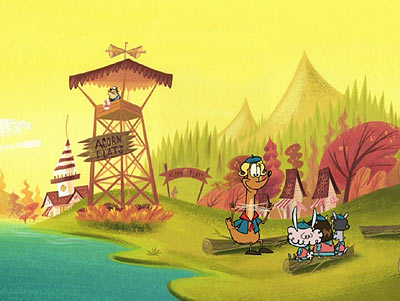

REVIEW: CAMP LAZLO (Cartoon Network)

Cartoon Network sends me screeners for their new shows and specials at least once a month, and I generally toss them straight into the trash to save myself the aggravation of watching contemporary TV animation. On a whim though, I decided to check out the latest one they sent for the new series CAMP LAZLO, set to debut July 8.
CAMP LAZLO was created by Joe Murray, whose earlier creation ROCKO’S MODERN LIFE aired on Nickelodeon in the mid-90s. He has spent the past few years pursuing children’s book illustration and other non-industry activities. The show is a graphic delight. The designs are crisp and appealing, and the animation is solid and moves nicely (with the occasional bit of creative action that is very funny, like the camp nurse who only rolls around in her swivel office chair without ever bothering to stand up). The strongest visual element in the show is the excellent art direction by Murray and art director Sue Mondt (POWERPUFF GIRLS), along with their crew of layout artists and bg painters, which includes SAMURAI JACK’s Dan Krall (check out his website to see some of his concept paintings for the show). The backgrounds are thoughtfully composed, and packed with inventive organic shapes and creative color schemes. The painting style uses a heavy textural approach, with a lot of visible “brush” and “colored pencil” effects, which seems perfectly appropriate to the show’s outdoor setting. It also shows that ‘modern’ backgrounds are possible without relying on the hard-edged geometric shapes that are so prevalent in designed animation nowadays.
The show owes a strong visual debt to Nick’s SPONGEBOB SQUAREPANTS. Some of the characters, like Slinkman and the Dung Beetles, look like they are designs taken right out of SPONGEBOB, but beyond these obvious examples, there is an overall graphic clarity and simplicity to the character designs that emits a heavy SPONGEBOB vibe. It’s not only in the design that the SPONGEBOB sensibility is felt, but many of the character expressions in LAZLO also look like they were taken directly from SPONGEBOB boards. This is not because the artists were copying Nick’s underwater series, but rather because many of the LAZLO artists are alumni of SPONGEBOB, including three of the show’s six storyboard directors: Kaz, Kent Osborne and Sam Henderson. The similarities to SPONGEBOB end however with the visual direction of the show; storywise and contentwise, unlike SPONGEBOB, CAMP LAZLO has minimal appeal and entertainment value for anybody outside of its target six-to-ten-year-old range.

CAMP LAZLO is an outright success artistically, but it falls apart where most other children’s animated series also tend to falter: specifically, annoying voice acting where too often speaking with a funny voice substitutes for acting, incessant dialogue, stock character types with underdeveloped personalities, and generally uninspired plotlines and storytelling. Fortunately, these elements are not offensively bad — say, on the excruciating level of a FAIRLY ODDPARENTS — but it is enough to prevent me from wanting to watch the show again.
It is incredibly perplexing to me that why, on a show with so many distinguished artists, the filmmakers feel the need to cover the artwork and action with wall-to-wall dialogue. Not even the talkiest Billy Wilder films have as much dialogue as some of these modern animated TV series. It’s not as if the characters are saying anything witty or having thoughtful exchanges of dialogue; they just yak, yak, yak, explaining every bit of action and every feeling they’re experiencing. On more than one occasion, I noticed a scene where the joke was purely visual, yet they had a character injecting a comment on top of the action. Not only was this unnecessary, but also incredibly distracting. For all the talking, it is ironic how little the show actually says. CAMP LAZLO lacks a strong point-of-view that compels the audience to make any type of emotional investment in the characters, or to feel one way or the other about their actions. In other words, it is typical, generic children’s TV animation. . . good-looking, but ultimately empty and unsatisfying.

